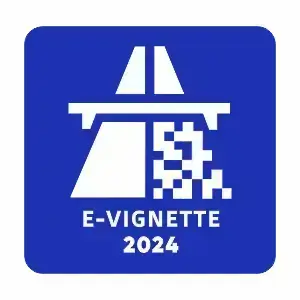Slovenian highways ensure fast and safe travel in the country's road traffic. These roads can be divided into two parts: highways and expressways. Motorways are marked with white signs on a green background, they are at least twice two-lane, and the maximum permitted speed is 130 km/h. Expressways are marked with white signs on a blue background, they are usually double-lane, but they differ from highways in that they do not have a stop lane, and the maximum permitted speed is 100 km/h.
The Slovenian motorways are owned and operated by the Motorway Company of the Republic of Slovenia. Since January 2011, DARS has managed 533.3 km of highways, 73.3 km of expressways, 161 km of connecting roads and 27 km of rest roads. The Slovenian motorway vignette system was introduced for passenger cars and motorcycles. In addition to highway tolls, the 8-kilometer long Karavanke tunnel connecting Slovenia with Austria also became subject to tolls.
Slovenia is part of the Schengen area, so there is no need to expect special checks at the Hungarian-Slovenian border. However, you must have a travel document, which means a photo ID, which can be a valid passport, identity card, or temporary identity card. Those who cannot prove their identity can expect a violation fine of up to €500. Those under the age of 18 must also have one of the mentioned documents. It is important to know that in Slovenia a driver's license is not suitable for proof of identity.
With Croatia joining the Schengen area, border controls on the Slovenian-Croatian border were abolished. Controls are still being carried out at the Austrian-Slovenian border, as a result of which congestion can be expected at the Karavanká tunnel during the busiest periods.
The speed limits for passenger cars are 50 km/h in residential areas, 90 km/h outside residential areas, 110 km/h on expressways, and 130 km/h on highways. The Slovenian police regularly checks the speed, and the average speed is measured in several places in the tunnels, where fines are imposed even after a minor speeding.
In the territory of the Republic of Slovenia, it is mandatory for all passenger cars to use daytime running lights and all available (front-rear) seat belts. According to Slovenian legislation, it is forbidden to smoke in a vehicle in which a person under the age of 18 is also traveling.
The A1 highway is 241 km long and provides easy passage between the Austrian border and the Adriatic Sea. The A2 motorway is a north-south motorway, 175 km long. In 2005, 133.1 km of the road was completed. The road goes from the Austrian border (A11) to the Croatian border (A3). Among others, it affects Jesecnice Kranj, Ljubljana and Novo Mesto and Brežice. The A3 motorway connects the A1 motorway with the port city of Trieste on the Italian border. The road is 12 km long and is managed entirely by DARS. It is also important in the relationship between the Balkans and Italy, as it also connects the region with Venice and Milan. The A4 motorway was originally planned to be 33.7 km long, connecting Maribor with the Croatian border. The highway runs along several larger cities, such as Maribor, Ptuj and Hajdina. They started building it in 2009, which is still going on today. It will be part of an important road, as it will be the shortest connection to Zagreb and several major European cities. The A5 highway, which is also referred to by many as the Muravidéki highway, connects Maribor directly with the Hungarian border. It joins the M70 motorway at the Hungarian border. The first section, which is 11.3 km long, was handed over in 2003, and was finally completed in 2008. The total length of the highway is 81 km. Together with the A1 highway, it forms a NATO Corridor through Koper and Hungary towards Ukraine.
Expressways include highway H3, 10.22 km long, the northern bypass of Ljubljana, highway H4: 42.1 km long, which leads to the Italian border, highway H7, 3, It is 5 km long, which helps to approach the Hungarian border.
In Slovenia, as in most countries, the purchase of motorway vignette is mandatory. It is best to buy this online, which is convenient and fast. The electronic sticker does not need to be stuck.
The Slovenian Motorway Vignette 2024 can be purchased here in the shop.



 Deutsch (DE)
Deutsch (DE)
 Greek (GR)
Greek (GR)
 Italiano (IT)
Italiano (IT)
 Magyar (HU)
Magyar (HU)
 Polski (PL)
Polski (PL)
 Română (RO)
Română (RO)
 Slovensky (SK)
Slovensky (SK)
 Slovenščina (SL)
Slovenščina (SL)
 Türkçe (TR)
Türkçe (TR)
 Česká (CZ)
Česká (CZ)








